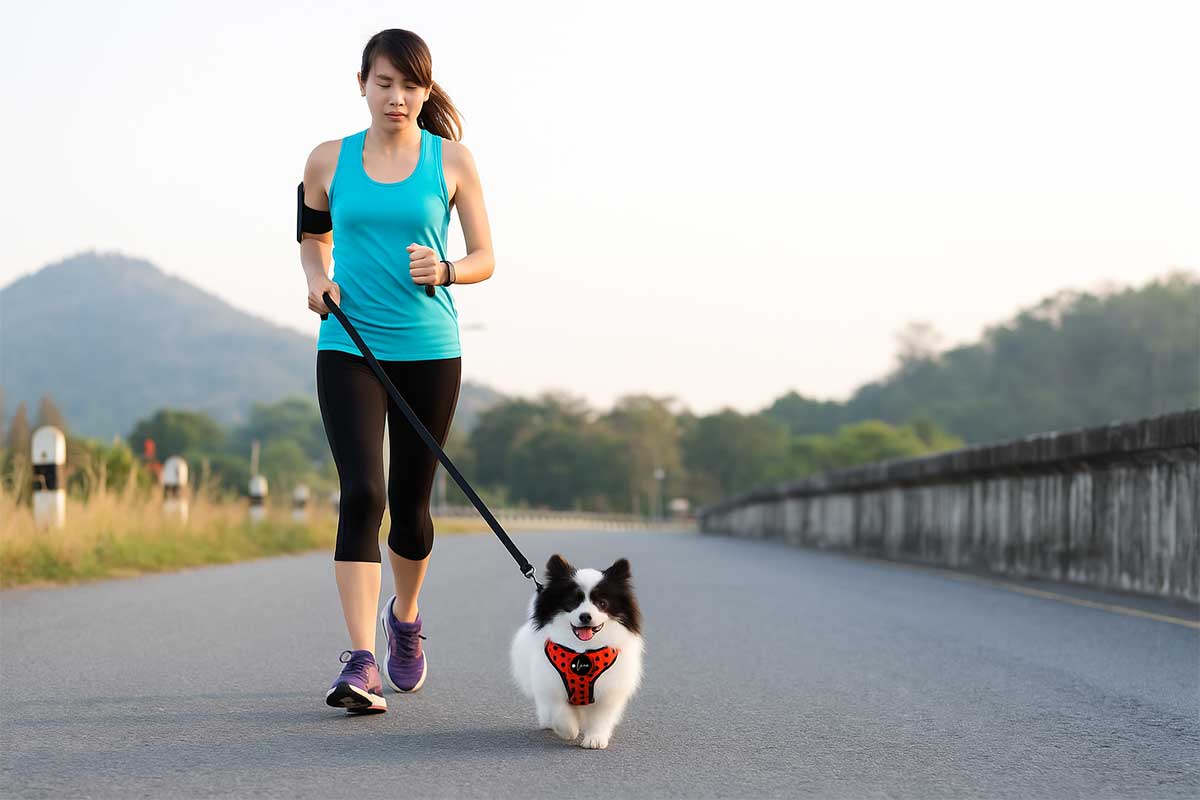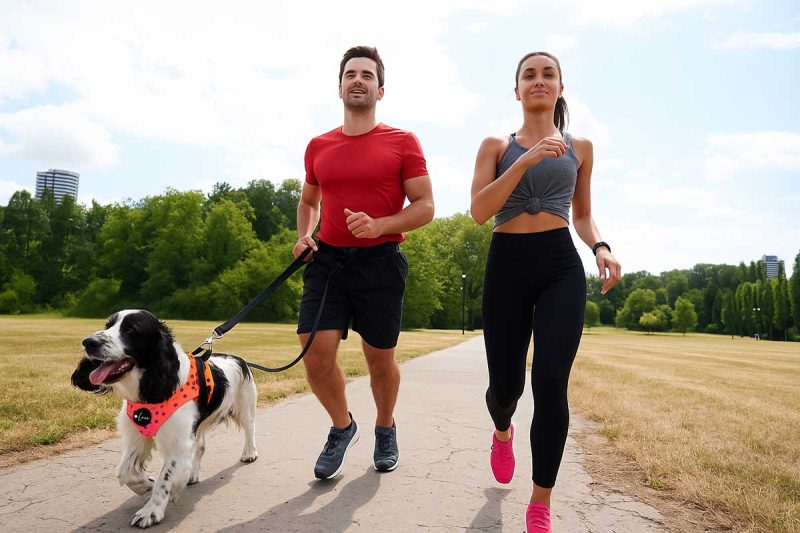Running with Dogs: A Stylish Guide for Dog Parents

Chic Joggers and Wagging Tails: Can You Run Stylishly With Your Dog?
Running with dogs might conjure images of muddy trainers and tangled leads, but it doesn’t have to. At The Luna Co, we believe even a jog around the park can be equal parts practical and polished. Whether you’re easing into a fitness routine or simply switching up your daily walk, a run with your dog can be a joyful, energising way to bond – and yes, you can look good doing it.
This post is here to show you how. We’ll explore the benefits of running with your dog, share expert tips on keeping both of you comfortable, and highlight the gear that makes a real difference. All with a focus on style, comfort, and SEO-friendly advice for anyone searching how to start running with their dog in the UK.
Why Run With Your Dog?
There’s a reason “running with dogs” is a rising search term among dog parents. More of us are looking for healthy ways to spend quality time outdoors, and running is a simple way to do just that. For dogs with energy to burn, it’s also a great behavioural outlet – helping reduce stress and restlessness. For humans, it’s accountability with a tail. You can’t skip a jog when those eyes are pleading at the door.
Running together also builds rhythm between you and your dog. You’ll learn to respond to each other’s pace, habits, and mood – creating a deeper bond beyond the average walk.
The Best Time of Day to Run With Your Dog
Mornings and evenings tend to be best for running with dogs, particularly during warmer months. Cooler air makes it easier on both paws and paws-in-trainers, while quieter streets mean fewer distractions. Midday runs are fine in winter but should be avoided in summer to protect your dog from overheating or paw pad burns on hot pavements.
If your dog is new to running, shorter sessions during quiet times (early morning or late evening) can be the most positive way to introduce the routine.
Choosing the Right Harness for Running with Dogs
When it comes to gear, the harness you choose is key. A well-fitted, step-in harness offers security without restricting movement – exactly what you want when your dog is on the move.
At The Luna Co, our step-in harnesses are designed with both comfort and elegance in mind. They’re especially ideal for dogs who dislike harnesses that go over their head, and they allow for smooth, friction-free motion when running. No twisting. No pinching. No wrestling your dog into it at 7am.
Pair your harness with a classic lead that gives you reliable control without the unpredictability of retractable ones. A good grip is essential for managing pace and direction on the go.
Explore our bestselling Step-In Harnesses and Dog Leads to find the right fit for your routine.

How to Stay Comfortable (and Stylish) When Running With Your Dog
If you’re someone who coordinates your pup’s collar with your trainers, you’re not alone. Running doesn’t mean you have to sacrifice your signature style. Choose breathable, fitted activewear that allows you to move freely, and consider a belt bag or crossbody pouch for treats, waste bags, and essentials.
Your footwear matters too – opt for supportive trainers you’re happy to see get a bit mucky. If your dog pulls, it’s even more important to have a steady foundation.
And of course, nothing says put-together like a matching set. A lead and harness in soft, complementary tones can turn your morning jog into a style statement.
Safety First: What Every Dog Parent Should Know
Start slow. Not all dogs are natural runners, and younger pups or certain breeds may need time to build stamina. Pay close attention to their breathing and gait – short, structured jogs are better than pushing them too far too soon.
Avoid hard, hot or icy surfaces that can damage paw pads. In summer, test the pavement with your hand. If it’s too hot for your palm, it’s too hot for paws.
Stick to reliable leads and never run with a retractable one – they can extend unpredictably and lead to injury.
Lastly, always bring water. Dehydration can come on quickly, especially if your dog is running in warmer conditions. Collapsible bowls are a handy on-the-go option.
Can All Dogs Run?
Not every dog is built for long-distance running — and that’s perfectly okay. Flat-faced breeds like French Bulldogs and Pugs can overheat quickly and often have difficulty breathing during sustained exercise. Similarly, smaller dogs like Dachshunds or toy breeds may prefer short, playful bursts of movement over structured runs.
Larger breeds like Spaniels, Retrievers, and Border Collies tend to love running and can often build up to longer routes with proper conditioning. But age, weight, and temperament all play a role too. The most important thing is to listen to your dog. If they lag, pull back, or look uncomfortable, slow down or switch to a brisk walk.
Running with dogs should be enjoyable for both of you — not a race.
What to Pack for a Stylish Jog With Your Dog
You don’t need a full hiking kit, but a few thoughtful extras can make a difference. Here’s our quick checklist:
-
Treats or kibble for positive reinforcement
-
A water bottle and collapsible bowl
-
Waste bags
-
A soft towel or wipes if your dog tends to get muddy
-
A belt bag to hold it all together (bonus points if it matches your dog’s accessories)
What Makes a Good Running Lead?
The lead you use can completely change your running experience. For running with dogs, you want something:
Non-retractable – for predictable control
Soft in hand – to prevent rubbing or friction burn
Mid-length – too short and your dog will feel tethered, too long and you’ll trip
Some dog parents use hands-free running leads that clip to a belt, which can be great for seasoned dogs with solid recall. But if your dog’s still a bit enthusiastic (or unpredictable), a classic lead with a good grip is a better option.
Explore our Dog Leads for strong, comfortable designs you can trust on the move.
Matching Energy, Matching Style
Running with your dog is more than just a way to tick the exercise box. It’s a shared rhythm, a daily ritual, and a little pocket of time where it’s just the two of you, moving in sync. At The Luna Co, we’re firm believers that comfort and style aren’t mutually exclusive — especially when it comes to dog gear.
So whether you’re jogging through your neighbourhood, exploring a leafy trail, or simply adding a few strides to your usual walk, we’re here to make sure your dog looks (and feels) as good as you do. That’s what well-dressed walkies are all about.
Ready to explore? Take a peek at our Step-In Harnesses and Matching Sets to add a little effortless elegance to your next outing.
FAQ: Running With Dogs
1. Which dog breeds are best for running?
Medium to large active breeds like Labrador Retrievers, Border Collies, Vizslas, and Australian Shepherds are typically well-suited to running. Some smaller breeds like Jack Russell Terriers and Whippets can also enjoy shorter jogs. Always consider your dog’s age, health, and personality before starting a routine.
2. Can small dogs run with you?
Yes, some small breeds like Cocker Spaniels, Jack Russells, and Whippets can enjoy short runs. Stick to softer terrain, avoid long distances, and keep an eye on fatigue.
3. What breeds should not run long distances?
Flat-faced (brachycephalic) breeds such as Pugs, French Bulldogs, and Shih Tzus often struggle with breathing and overheating. Heavier or short-legged breeds like Dachshunds, Basset Hounds, and Saint Bernards are also not ideal for sustained jogging.
4. Is it safe to run with a puppy?
No – puppies’ joints are still developing. Running can put too much strain on their growing bodies. Wait until your dog is fully grown and always check with your vet first.
5. What kind of harness is best for running with dogs?
A step-in harness is ideal for running. It avoids pressure on the neck, allows full shoulder movement, and stays secure while jogging. At The Luna Co, our step-in harnesses are made for comfort and fuss-free fit.
6. Should I use a retractable lead when running with my dog?
No, retractable leads can be unpredictable and unsafe while running. Use a fixed-length lead that gives you control without tangling or lag.
7. What should I bring when running with my dog?
Bring treats, water (for both of you), poo bags, and a comfortable lead and harness. A belt bag can help carry it all without ruining your look.
Share This Post


